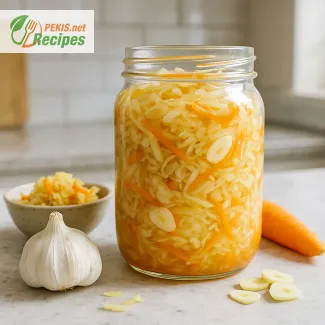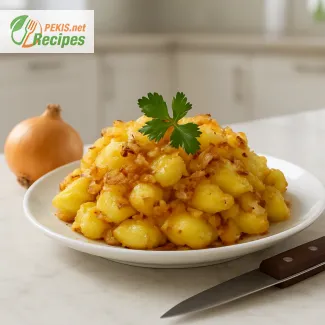
Traditional Slovenian Braised Sauerkraut – A Timeless Comfort Food
Exploring the rich heritage behind Slovenia’s beloved kislo zelje
Braised sauerkraut, or dušeno kislo zelje, is one of the most iconic Slovenian dishes deeply rooted in the culinary traditions of Central Europe. This rustic side dish represents much more than just fermented cabbage—it's a warm symbol of hearty mountain cuisine, often accompanying meat-heavy winter feasts, Sunday roasts, or festive sausages. With its deep, tangy flavor and perfectly balanced texture, braised sauerkraut has stood the test of time, evolving from a humble preservation method into a refined staple that brings comfort and nostalgia to every Slovenian table.
What sets Slovenian braised sauerkraut apart from other regional variations is its delicate layering of flavor, often enhanced with ingredients like bay leaves, juniper berries, onions, and smoked meats. These additions transform simple sauerkraut into a rich, savory dish that warms the soul and highlights the resourceful nature of Slovenian farmhouse cooking. The slow braising process not only mellows the acidity of the fermented cabbage but also infuses it with the aromatic warmth of traditional seasonings, making it the ideal companion for blood sausages, pork knuckles, or Carniolan sausage (kranjska klobasa).
The cultural significance of sauerkraut in Slovenian cuisine
For centuries, sauerkraut has played a central role in Slovenian kitchens, particularly during the colder months when fresh vegetables were scarce. As a preserved food, it provided essential nutrition through long winters and was traditionally made in large barrels stored in cellars. Each household took pride in their own fermenting method, and every family had its own unique way of preparing braised sauerkraut—some preferring it with a hint of sweetness, others with a pronounced smokiness.
Its association with traditional Slovenian celebrations and holiday meals further elevates its cultural value. No proper Martinovanje (St. Martin’s Day) or New Year’s feast is complete without a generous serving of braised sauerkraut, typically served alongside roast pork or pečenica. This makes it not only a dish of sustenance, but one of festive unity, bonding generations at the table through familiar, time-honored flavors.
How slow cooking enhances the character of sauerkraut
The magic of this dish lies in the slow braising process, which softens the cabbage and allows the sour notes to blend harmoniously with sweet, smoky, and savory undertones. By simmering gently with onions, garlic, bay leaves, and sometimes apple slices or a splash of white wine, the sauerkraut develops a complex, layered taste that is both tangy and subtly sweet. The process transforms a pungent ferment into a deeply satisfying side that complements a wide variety of meats and starches.
The careful balance between acidity and richness is what makes Slovenian-style braised sauerkraut so beloved. When cooked properly, it retains just enough bite to remind you of its fermented origins, yet becomes silky and tender, releasing a mouthwatering aroma that instantly evokes comfort and home.
Key ingredients that define the dish
To achieve authentic Slovenian flavor, it’s crucial to use high-quality fermented sauerkraut, preferably homemade or from a local producer. The supporting elements—like finely chopped onions, bay leaves, and fat from smoked pork or bacon—serve not only as aromatics but also as a bridge between the sauerkraut and the main course. Some variations include caraway seeds, juniper berries, or apple slices, which lend a touch of sweetness and depth.
Adding flour or potato starch at the end of the cooking process is a traditional method to slightly thicken the braising liquid, enhancing its ability to coat sausages or roasted potatoes. The choice of fat—whether lard, oil, or rendered bacon—can shift the dish’s character from rustic to refined, making it adaptable to both casual family dinners and elegant heritage meals.
Pairings that elevate the Slovenian sauerkraut experience
Braised sauerkraut is not just a side dish—it is a centerpiece in traditional Slovenian menus. It pairs exceptionally well with roasted pork shoulder, blood sausage, Carniolan sausage, or even duck confit. On the starch side, classic pairings include boiled potatoes, buckwheat mush (ajdovi žganci), or slices of homemade rye bread.
For a full Slovenian culinary experience, serving braised sauerkraut with a glass of dry white wine—such as Šipon or Rebula—adds a fresh counterpoint to the dish’s richness. Alternatively, a light beer works well, particularly with meat-heavy combinations.
This dish remains a treasured part of Slovenian heritage cuisine, bridging the gap between past and present, and delivering deep flavor from humble ingredients with every bite.
1. Prepare the base:
In a large pot, heat the lard or oil over medium heat. Add the finely chopped onion and sauté for about 5 minutes, until translucent. Add the minced garlic and continue to cook for 1 minute, stirring constantly to avoid burning.
2. Add smoked bacon:
Stir in the diced smoked bacon and let it render its fat and become lightly browned, about 5–7 minutes. This will form the smoky foundation of the dish.
3. Add sauerkraut and spices:
Rinse the sauerkraut lightly under cold water if it is too sour, then drain thoroughly. Add the sauerkraut to the pot and mix well with the onion and bacon. Add the bay leaves, juniper berries, and (optional) caraway seeds. Stir in the grated apple if using.
4. Deglaze and braise:
Pour in the white wine and stir to deglaze the bottom of the pot. Let the alcohol evaporate for 2–3 minutes. Add water or broth, season with salt and pepper, and bring to a gentle simmer.
5. Slow cook:
Cover the pot and simmer over low heat for about 45 minutes, stirring occasionally. If needed, add a bit more water during cooking to keep the mixture moist but not watery.
6. Final thickening:
In a small pan, heat 1 tablespoon of lard or oil and stir in the flour. Cook for 1–2 minutes to form a light roux. Stir this into the sauerkraut and cook for another 5 minutes uncovered, until the liquid thickens slightly.
7. Serve:
Remove the bay leaves and juniper berries. Taste and adjust seasoning. Serve hot as a side dish with sausages, roast pork, or potatoes.
Creative Enhancements for the Classic Braised Sauerkraut
Modern techniques and ingredient swaps that elevate the traditional dish
While the traditional Slovenian braised sauerkraut (dušeno kislo zelje) holds a cherished place in Central European culinary culture, many modern cooks are exploring ways to enhance its flavor, improve its nutritional profile, or adapt it to dietary preferences. Thanks to its flexibility, this dish offers ample opportunity to create healthier, richer, or more refined variations, without losing its authentic identity.
How to improve flavor depth with ingredient additions
A classic braised sauerkraut recipe is already rich and aromatic, but there are a few strategic additions that can bring out deeper flavor layers:
- Smoked paprika (1 tsp): Adding this spice intensifies the smoky aroma, complementing the bacon and giving the dish a slightly earthy warmth.
- Caramelized onions instead of just sautéed ones: This small change increases natural sweetness and balances out the acidity of sauerkraut.
- Shredded carrots (50 g): These add a gentle sweetness, more texture, and a hint of color contrast, making the dish more visually appealing.
- Fresh thyme or marjoram: These herbs introduce subtle floral notes, which pair beautifully with the tangy sauerkraut and pork flavors.
Each of these additions enhances the complexity of the dish while keeping its rustic essence intact.
Healthier ingredient alternatives and their impact
If you're aiming for a lighter or more nutritious version, several ingredient swaps can be made without sacrificing taste:
- Replace bacon with lean smoked turkey or plant-based alternatives. This reduces saturated fat and cholesterol, making the dish suitable for heart-conscious eaters.
- Use olive oil instead of lard. While lard adds traditional richness, olive oil provides unsaturated fats, which support cardiovascular health.
- Substitute apple slices with grated pear or dried cranberries for a different sweet-tart profile. These fruits contribute antioxidants and visual appeal.
- To reduce sodium, rinse the sauerkraut thoroughly and cook with low-sodium broth instead of salted water or standard bouillon.
These adjustments make the dish more accessible for people following modern dietary guidelines, without losing the core flavor that makes braised sauerkraut so comforting.
Why homemade braised sauerkraut always tastes better
Preparing this dish from scratch delivers a more personalized, flavorful experience. Store-bought versions often lack the depth and balance achieved by slow braising, and may contain preservatives or excess sodium. When made at home, you can control:
- The level of acidity (by rinsing or not rinsing the sauerkraut),
- The texture (from crunchy to soft),
- And the flavor base (customizing the type and amount of aromatics, herbs, or fats used).
Furthermore, homemade versions allow for fresh ingredients that improve both taste and texture, such as freshly minced garlic, crisp local apples, and high-quality smoked meats. These subtle differences often translate into a richer, cleaner-tasting dish.
Common mistakes to avoid in preparation
To make a successful braised sauerkraut dish, it's important to avoid several frequent pitfalls:
- Overcooking the cabbage: This leads to mushy texture and a loss of the sauerkraut's signature tang.
- Skipping the browning step for onions and bacon: This step builds the umami base of the dish. Without it, the final flavor will feel flat.
- Using too much liquid: Braised sauerkraut should be moist, not watery. Excess broth can dilute the intensity.
- Not adjusting for salt after adding bacon or broth: These components are already salty, so it's crucial to taste before seasoning.
- Leaving spices in the dish (like juniper berries or bay leaves) when serving: They can overpower bites and should be removed before plating.
Awareness of these common issues will help you achieve consistency and refinement every time you prepare the dish.
Regional and seasonal variations worth exploring
Slovenian households across different regions have their own unique takes on braised sauerkraut. Some variations to try include:
- Adding millet or barley to make the dish heartier and turn it into a one-pot meal.
- Incorporating fermented turnip along with sauerkraut for a stronger, rustic flavor.
- Preparing the dish with wild game fat (such as duck or goose) for festive winter meals, lending a decadent richness.
- Mixing in sour cream or crème fraîche before serving for a creamy, slightly tangy finish that adds Slavic elegance to the rustic base.
Seasonal adaptation also matters—sauerkraut pairs differently with spring herbs or autumn root vegetables, making the dish versatile year-round.
Texture and aroma refinement techniques
Texture is a crucial element of well-made braised sauerkraut. If it turns out too dry or soggy, the dish can feel unbalanced. To control this:
- Simmer gently with the lid ajar to evaporate excess moisture while retaining softness.
- Add a small amount of roux or mashed potatoes to thicken the liquid slightly at the end.
- Use freshly ground pepper and light vinegar drizzle just before serving to reawaken the aromas and acidity.
A well-textured sauerkraut has a pleasant bite, layered with soft onion strands and bits of juicy bacon or smoked meats. The aroma should be inviting, not sharp or overpowering.
Final flavor-boosting tips from Slovenian grandmothers
Traditional home cooks often have subtle but effective tricks to deepen flavor:
- Drop in a clove or a star anise for background spice notes—just one is enough.
- Add a teaspoon of honey or maple syrup during the last 5 minutes of cooking to round out the acidity.
- For a luxurious texture, mix in a knob of butter just before serving. It creates a silky finish and enhances mouthfeel.
These small touches, often passed down through generations, are what separate an ordinary sauerkraut from a remarkable culinary experience. Each version tells its own story, steeped in family tradition yet open to creative evolution.
Allergens present in the recipe:
- Gluten: present (flour)
- Pork (smoked bacon): allergenic for certain diets
Tips for allergen and gluten replacement:
- Replace flour with cornstarch or gluten-free flour to make the recipe gluten-free.
- For a pork-free version, use smoked turkey or tempeh.
- Use sunflower oil or olive oil instead of lard for a plant-based version.
Vitamins and minerals per serving (approximate):
- Vitamin C: 28 mg – supports immune function and skin health
- Vitamin K: 18 µg – essential for blood clotting and bone metabolism
- Vitamin B6: 0.2 mg – helps in brain development and immune function
- Iron: 1.5 mg – supports oxygen transport in the blood
- Potassium: 420 mg – regulates fluid balance and muscle contractions
- Magnesium: 20 mg – aids in nerve function and energy production
- Calcium: 45 mg – important for bone strength and metabolic functions
Antioxidants per serving (approximate):
- Lactic acid bacteria (from sauerkraut): supports gut flora and digestive health
- Quercetin (from onion): 12 mg – anti-inflammatory, supports heart health
- Polyphenols (from apple and wine): 18 mg – reduce oxidative stress
- Allicin (from garlic): 2 mg – antibacterial and immune-boosting properties
- Vitamin E: 1.2 mg – protects cell membranes and supports skin health





